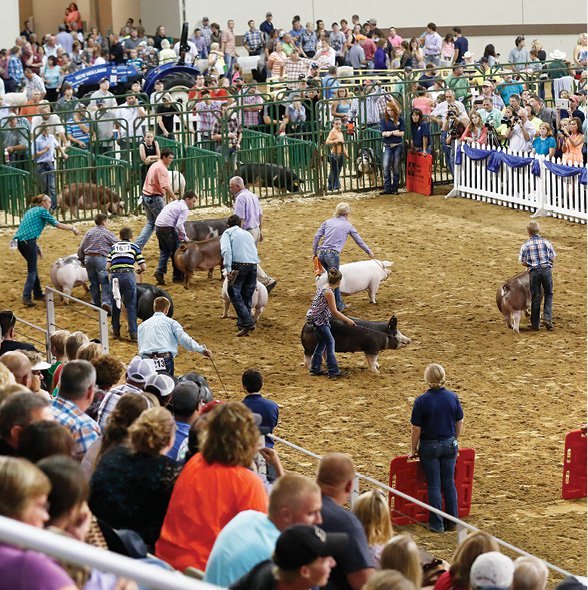Speed Read: High on the Hog

More animals, less pitbull.
This year, the Fair is doubling down on its farm component, reserving the Coliseum for livestock only and jettisoning big-name concerts (though plenty of free shows abound, in case you’re into Night Ranger). The Fair is “the premier event of the summer for the show-pig industry,” says Bret Vickrey, who has run Vickrey Show Pigs in Warren for more than 15 years. And it’s getting back to its core agricultural values.
The 7,530 pig entries are split into two shows.
That’s the Open Competition and the 4-H Show, which is geared toward the younger set.
But will they make yummy pork chops?
In the 4-H competition, barrows are judged on build, muscle tone, and how well they’ll contribute to the bottom line as commodity product (i.e., will they taste good). Gilts are judged on their breeding ability. If it sounds nebulous, it is—judges have personal tastes, and are often in the breeding business themselves. “The best way to term it is that you want barrows that look good to eat, and gilts that look like good mothers,” says livestock manager Emily Griffiths.
The scene is also a pig showroom. Breeders and exhibitors scan the room and winners’ circle for top-notch breeding animals. Quality boar semen, incidentally, can run from $100 to $1,000 a bottle.
The piggy market has gone global.
4-H competitions used to be the territory of homespun, enterprising youngsters. But in the past decade, the show-pig market has been driven online, and today’s breeders buy and sell to anybody they can reach with a truck. “The internet has opened up a whole new arena. Everybody tries to find that one that has juuuust a little better chance,” says Vickrey. Two sites rule the roost: showpig.com, where the average sale price topped $1,000 in 2015, along with thepigplanet.com, owned by Travis Platt of Platt Showpigs in Roanoke, Indiana.
The fair doesn’t care either way.
To be eligible, your pig just has to be owned by a 4-H member by May 15. “There really isn’t any advantage to raising or purchasing,” says Aaron Fisher, 4-H Extension Specialist at Purdue. “There are certainly as many 4-H members who win with animals they raised as there are purchased.”
Know your pig words. The broad term is swine. The terms pig and hog can be used interchangeably. Males are barrows being prepared for harvest, aka your future bacon. The ladies are gilts.
Still, to help even things out, this year’s fair is offering some extra Indiana love.
The new Hoosier Heritage program recognizes Indiana breeders and offers incentives and awards to 4-H exhibitors who showcase state-grown stock.
Pigs run pricey.
Good pigs can cost $200 to $400, though the sky’s the limit, says Fisher. “There are definitely levels,” agrees Vickrey. “But if I buy a barrow for $500, and take care of him to the best of my ability, he can beat a $1,500 or $2,500 pig.”
Winners ride high on the hog.
The Fair has budgeted $65,000 in prizes; the top barrow gets about $8,000, and the scale steps down from there. It’s solid money, but Platt says marquee shows in Texas pay out $200,000 to top barrows. (You can only win once, and then they bar you.)
So how do you raise a prize pig?
Well, there’s the matter of pedigree—and that’s where those with deep pockets have the advantage. But it also takes optimal diet, nutrition, and exercise (it’s not uncommon for breeders to take their unleashed pigs on long, relaxing walks). “Just like people, pigs need to stretch their muscles, and get lots of fresh, clean water,” says Griffiths. Then they’re in hog heaven.





